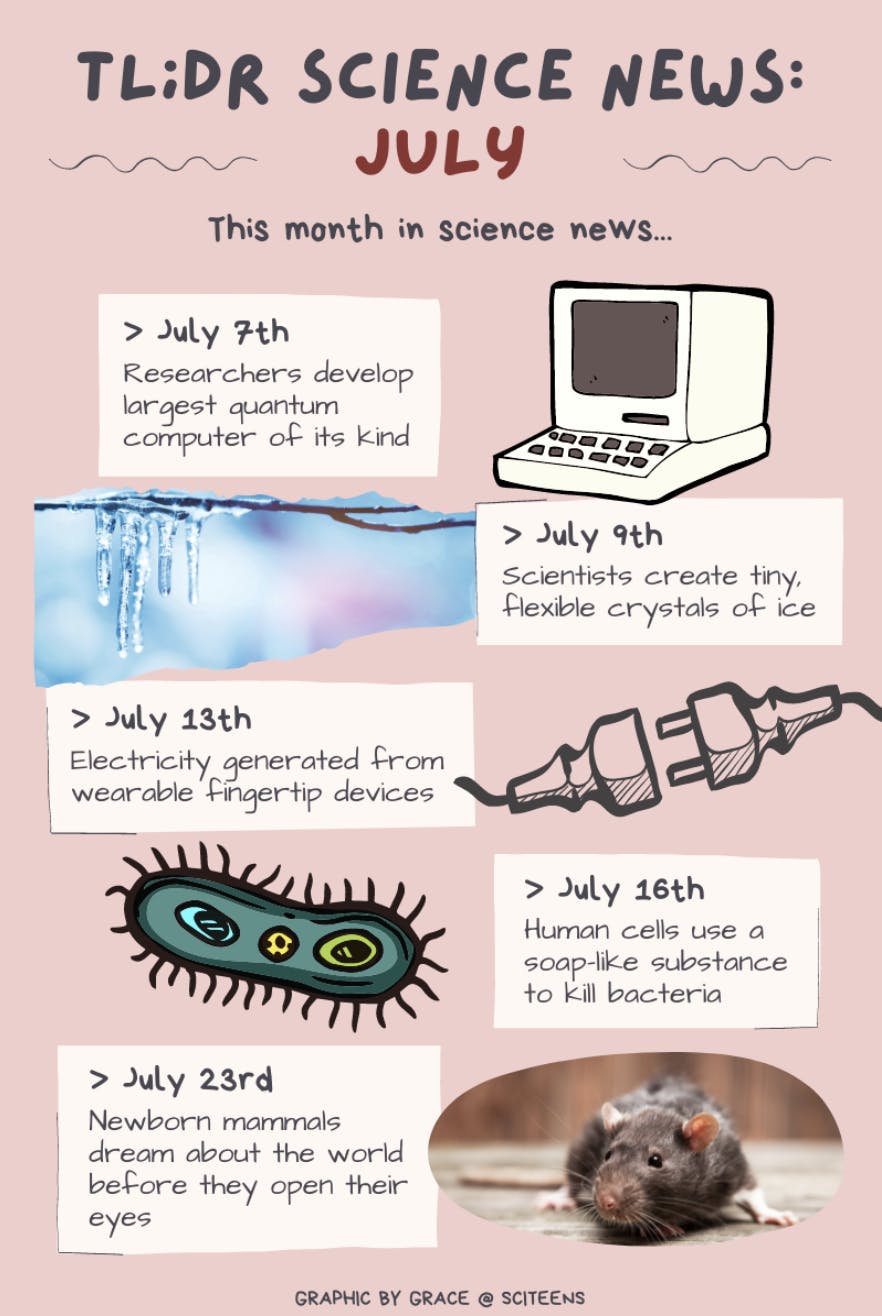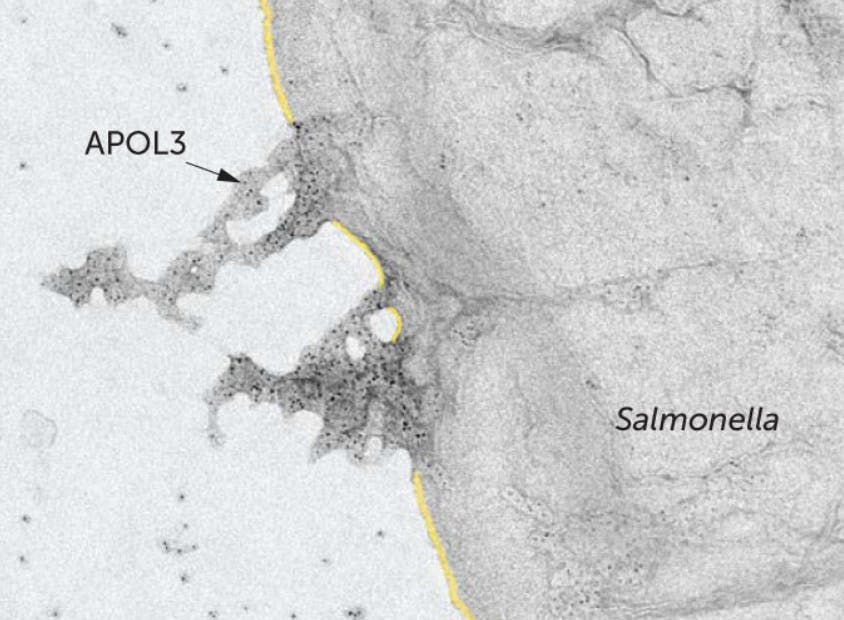SciTeens’ Ampere News: 5 Cool Current Science Events From This July
By Grace Jiang
July 28, 2021 · 7 minute read
Welcome back to SciTeens’ Ampere News! At the end of each month, we publish an article highlighting some interesting developments in the world of science over the last thirty(ish) days. For today's edition, we'll provide a summary of science news from July.
For those curious as to why we named the series Ampere, the ampere is the standard unit of measurement of electrical current. Likewise, we hope that SciTeens will become the standard for keeping up with the most interesting and current news in STEM! The following infographic summarizes what we have in store for this month; feel free to scroll through and jump right to which story seems the most interesting to you!

1. Researchers develop largest quantum computer of its kind
What happened?
Currently, we are relying on supercomputers for large-scale computation needs. Supercomputers are essentially very large computers. Like the desktop and laptop computers regular people use, supercomputers use “bits” to store information. Bits can only hold one of two values: either a 0 or a 1. Combinations of these 0s and 1s can be used to represent more complex information.
On the other hand, quantum computers use “qubits,” or quantum bits. Unlike regular bits, qubits are not restricted to only having the value of 0 or 1. Instead, they can have any linear combination of the two values (for example, a qubit could be 10% 0 and 90% 1 or 60% 0 and 40% 1). The ability of qubits to simultaneously hold multiple values allows quantum computers to perform calculations at a much faster rate than supercomputers.
To better understand the basics of quantum computers, watch this video: https://www.youtube.com/watch?v=JhHMJCUmq28
As reported in a paper published on July 7th, a team of researchers has developed a type of quantum computer called the “programmable quantum simulator” capable of operating with 256 qubits, making it the largest quantum computer of its kind.
How did it happen?
In the past, the same researchers developed a programmable quantum simulator capable of reaching 51 qubits. To do this, they used a one-dimensional array of focused laser beams to move ultra-cold atoms into specific arrangements. While the scientists arrange these atoms, they are also controlling the positioning of information-storing qubits.
The new system that the scientists have recently developed takes this same idea but moves it up a step: the array of laser beams was made to be two-dimensional. With a two-dimensional array, the atoms can be moved with greater precision to form a greater variety of arrangements. Off of these arrangements, the researchers are able to program algorithms and simulations.
Why does this matter?
Quantum computers perform computations much faster than supercomputers. Yet, we’re still using supercomputers for large-scale computations. Why is this the case?
The answer lies in the fact that although qubits can hold more information than regular bits, they are also much more fragile; the slightest disturbance from the outside environment can alter the information stored in a qubit. However, as researchers make further developments in quantum computing, we move closer to a world where quantum computers may replace supercomputers.
2. Scientists create tiny, flexible crystals of ice
What happened?
In a report published on July 9th, scientists create thin crystals of ice that can be bent and can spring back to their original shape.
How did it happen?
The researchers applied an electric voltage to a needle in a chilled chamber. This caused the needle to attract water vapor, forming tiny ice whiskers only a few micrometers in diameter. With a force applied to either end, the ice crystals could be bent significantly into a partial circle. When the force was released, the crystals regained their original shape.
Why does this matter?
Almost always, ice contains tiny defects. They could be small cracks, air bubbles, or improperly aligned sections of the crystal. In this study, the tiny crystals of ice contained no defects, so they exhibited unusual properties, not cracking or snapping when bent. A new, unexpected property of ice has been discovered.
3. Electricity generated from wearable fingertip devices
What happened?
In a report published on July 13th, researchers describe a new wearable technology capable of harvesting fingertip sweat to generate electricity. The device is thin, flexible, and wraps around the fingertips as shown in the image below.

Yin et al/Joule 2021
How did it happen?
Sweat contains a byproduct called lactate, which can be further broken down to produce energy. The fingertips are one of the places on the body with the highest concentration of sweat glands. Because fingertips continuously make sweat (it usually evaporates before you notice it), the scientists decided to use fingertip sweat for their device.
Using an absorbent gel that sits against the skin, the device captures sweat. On top of the gel are foam blocks with an enzyme (a molecule that speeds up the rate of chemical reactions) that takes electrons from lactate. Those electrons are then used to convert oxygen to water. Through this, electrons flow through the device, and electricity is generated: “300 millijoules of energy per square centimeter during a night’s sleep—enough to power a wristwatch for a day.”
Why does this matter?
The researchers hope to use the electricity generated from these fingertip devices to power wearable sensors that can measure a person’s glucose, urea, and other health indicators. One major hurdle of such sensors is the ability to sustainably provide them with electricity. With, as the researchers say, “the most efficient sweat-powered energy harvester yet,” wearable health indicators are becoming a very possible reality.
4. Humans cells use a soap-like substance to kill bacteria
What happened?
Soap is a type of detergent, a substance that can dissolve lipids (a type of organic molecule that oils and fats are made up of). Detergents are able to break up the outer layer of cells, the cell membrane, because it is composed of lipids.
In a paper published on July 16th, scientists discover that human cells can release a detergent-like protein to destroy the cell membranes of bacteria, killing the bacteria and protecting themselves from infection.
How did it happen?
The researchers from the study knew that, upon detecting a foreign pathogen, immune cells within the body emit signals that target other cells, including the epithelial cells that line the throat and intestines. When these cells receive the signals, they begin to fend off the invader. However, the researchers were interested in how exactly the cells are able to defend themselves.
In the laboratory, scientists first infected human epithelial cells with Salmonella bacteria. They then screened a variety of human genes and discovered a gene that, when disabled, caused the cells to succumb to the infection. This gene contained the instructions for a protein called “APOL3.” Using a strong microscope, the scientists were able to see small black dots, molecules of the APOL3 protein, attacking and dissolving the Salmonella cell membrane.

R.G. Gaudet et al/Science 2021
Why does this matter?
While certain parts of the immune system, like antibodies and white blood cells, have been extensively studied, hidden parts like this APOL3 protein haven’t gotten much attention. With this study, one more player of the complex human immune system has been uncovered.
5. Newborn mammals dream about the world before they open their eyes
What happened?
In a study published on July 23rd, scientists find through newborn mice that mammals are able to, in a sense, dream about the world they will experience before they even open their eyes.
How did it happen?
Newborn mice don’t typically open their eyes until the 11th or 12th day after birth. The team of scientists imaged the brains of mice soon after birth but before they first opened their eyes. They specifically studied waves of retinal activity, detectable activity that developing retina (the inner lining of the eye that allows for vision) produce.
In the newborn mice, waves of retinal activity flowed in a pattern resembling that of the mice running through their natural environment. This suggested that the developing mouse retina “practices” beforehand the images that the eyes would later experience, in a way similar to dreaming.
Why does this matter?
The scientists’ findings provide insight into why mammals are born capable of certain behaviors typically seen as requiring the ability of sight. For instance, the experiment explains why baby mice can navigate their surroundings soon after birth and why human babies can immediately detect objects and motion. It’s interesting to think that mammal brains prepare for the outside environment before they experience it at all.
Wrapping Up:
- Researchers use a 2-D array of focused laser beams to move atoms into arrangements for a 256-qubit quantum computer
- Tiny ice crystals with no defects can be bent without breaking and can afterwards spring back to their original shapes
- Scientists build a wearable fingertip device that converts the lactate in sweat into electricity
- Human epithelial cells can make APOL3, a detergent-like protein that dissolves the cell membranes of bacteria
- Brain activity in newborn mice resembles that of mice running through their environment, suggesting that mammals dream about the world before they experience it
Did you enjoy this article?
About The Author
Grace Jiang is currently a senior at Pine View School. She loves many things, the most notable of which being ice cream, harp seals, bubble tea, and (of course!) science. Definitely go contact her at grace@sciteens.org if you have any future article recommendations or just want to discuss life.